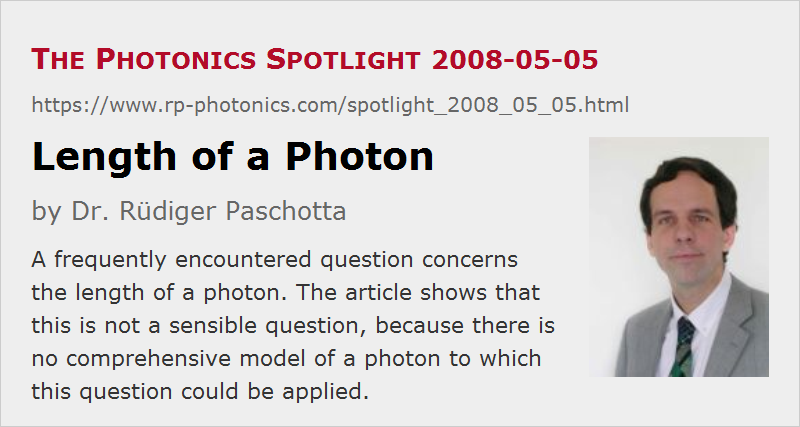Length of a Photon
Posted on 2008-05-05 as a part of the Photonics Spotlight (available as e-mail newsletter!)
Permanent link: https://www.rp-photonics.com/spotlight_2008_05_05.html
Author: Dr. Rüdiger Paschotta, RP Photonics Consulting GmbH
Abstract: A frequently encountered question concerns the length of a photon. The article shows that this is not a sensible question, because there is no comprehensive model of a photon to which this question could be applied.

Ref.: encyclopedia article on photons
A question which is frequently brought up by lay persons, but sometimes also by journalists reporting about some scientific experiments, concerns the length (and possibly also the transverse extent) of a photon.
The trouble with that question is essentially that the photon is a theoretical construction which does not have any straightforward connection either with an entity of physical reality or with anything simple which we can imagine. Some people are so much disturbed by this problem that they even consider the notion of photons and the corresponding scientific theories as totally flawed. Others adhere to more or less mechanistic models of photons and feel free to equip those with some details which actually do not occur in any of the common scientific theories. The latter approach can lead to questions such as the one concerning the length of a photon. If a photon were known to be something like a hard particle, or alternatively perhaps a wave packet, some kind of length could easily be defined. According to quantum theory, however, a photon is neither simply a particle nor simply a wave; instead, it has properties both of particles and waves, or more precisely speaking, the phenomenon of light exhibits both features of particles and waves.
In this situation, it doesn't even make sense to ask about the length of a photon. If answers are given anyway, confusion is the natural consequence. Some people argue that a photon cannot be larger than the area which is filled by light, and this limits e.g. the transverse extent of photons in laser beams. Others consider the transfer of one photon energy to an atom, and conclude that this energy must be much more concentrated. Another approach is setting a lower limit to the extent, essentially by considering the minimum pulse duration of light with a certain optical bandwidth, and multiplying this with the velocity of light in order to convert it into a length.
Obviously, all these thoughts are based on particular physical models of reality, not on observations. The manifold of mutually contradicting results just reflects the manifold of more or less suitable physical models and more or less appropriate interpretations of those. In other words, there is no comprehensive model of a photon of a kind which makes that question sensible. At most, it can make sense to ask about the length in one particular sense, but not about the length of a photon.
By the way, the encountered problem is not specific to photons. The same occurs e.g. with electrons. In some sense, an electron can be considered as a point-like particle, but we also know about the electron's wave properties and in fact use wave functions which can be as extended as a whole atom or even a whole crystal. This leads to another hint for those denying the existence of photons (or more precisely, the validity of any photon concept) based on such problems: if you decide for that path, then you should do the same with electrons, protons, neutrons, etc., which also have a wave nature.
This article is a posting of the Photonics Spotlight, authored by Dr. Rüdiger Paschotta. You may link to this page and cite it, because its location is permanent. See also the RP Photonics Encyclopedia.
Note that you can also receive the articles in the form of a newsletter or with an RSS feed.
Questions and Comments from Users
Here you can submit questions and comments. As far as they get accepted by the author, they will appear above this paragraph together with the author’s answer. The author will decide on acceptance based on certain criteria. Essentially, the issue must be of sufficiently broad interest.
Please do not enter personal data here; we would otherwise delete it soon. (See also our privacy declaration.) If you wish to receive personal feedback or consultancy from the author, please contact him e.g. via e-mail.
By submitting the information, you give your consent to the potential publication of your inputs on our website according to our rules. (If you later retract your consent, we will delete those inputs.) As your inputs are first reviewed by the author, they may be published with some delay.
 |





If you like this page, please share the link with your friends and colleagues, e.g. via social media:
These sharing buttons are implemented in a privacy-friendly way!